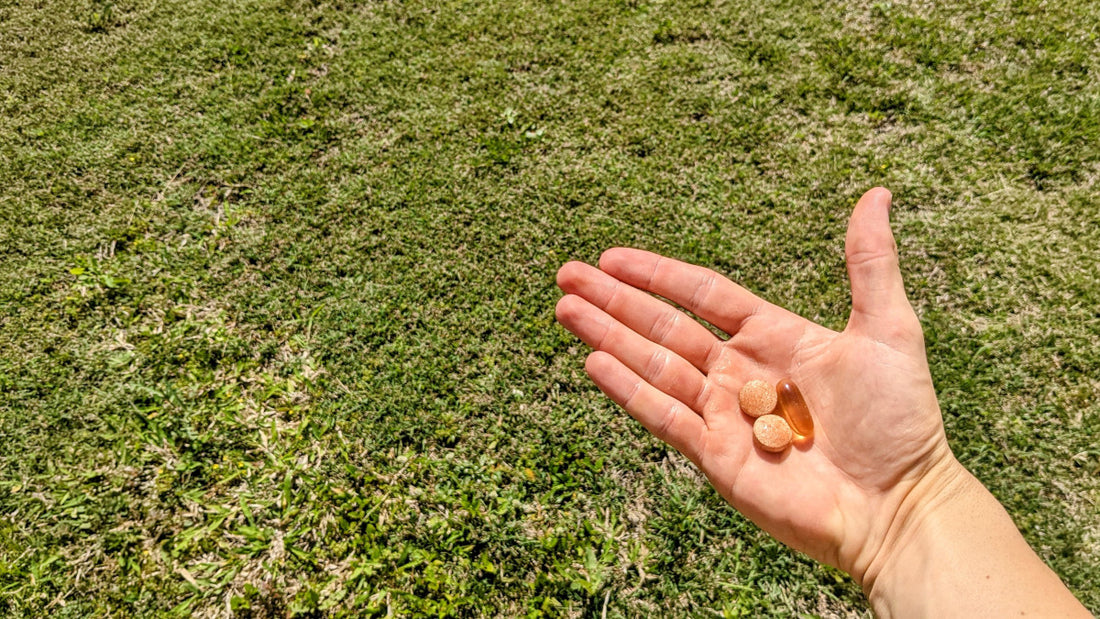Living right along the Tropic of Capricorn (the area of the world that receives the most sunlight year round), I’m lucky to be hit with high-test solar rays almost every single day. And I almost never get sunburnt. How do I do it?
I credit most of it to a tan and sensible sun exposure: when you’re at the beach and start to feel yourself burning (which I find a more acute sense of when I don’t wear sunscreen), wrap a towel around yourself or get in the shade. But I’ve recently learned of a few simple tools that could help even more.
In 1998, researchers wanted to test the protective effects of vitamins C and E against sunburn in humans. Previous research had suggested photoprotective effects of topical C and E in animals, and topical vitamin E application is an established method of reducing UV-induced reactions.
Found in high levels naturally in fruits (heavy hitters include oranges, kiwis and guavas), vitamin C is a potent antioxidant needed for the growth, development and repair of body tissue. Vitamin E is another antioxidant, however it is fat-soluble and found mostly in meat, seeds and nuts.
In a double-blind placebo-controlled study, Eberlein-König et al. (1998) administered either 2000mg of vitamin C combined with 1000IUs of vitamin E or placebo to a total of 20 participants for eight days (10 control group, 10 intervention). Skin UV sensitivity was measured using UV-emitting light bulbs both before and after the supplementation protocol. The main variable of focus was the lowest dose of UV required to elicit a sunburn 24 hours after exposure, or the minimal erythema dose (MED).
After the trial, the placebo group experienced a decrease in MED, with the median MED dropping from 80 to 68.5 mJ/cm2 after eight days. However, the intervention group saw an increase in median MED from 80 to 96.5 mJ/cm2 (p < 0.01).

This meant that those who took the supplements were 21% more resistant to sunburn. For most participants in the supplementation group, vitamins C and E acted as a sun-shield and boosted the body’s ability to withstand higher doses of UV. Interestingly, further research (Eberlein-König and Ring, 2005) has stated that while neither compound is remarkable on its own, significant improvements can be seen when both are taken together.
It’s hypothesised that while neither vitamin is capable of blocking UVA or UVB radiation per se, their antioxidant properties greatly assist the body in scavenging free radicals associated with sun damage. This means that vitamins C and E might protect you from sunburn after the fact.
What about newer research? Well, in 2020, Granger et al. tested a similar supplementation routine for sun-protective effects. Over 12 weeks, participants ingested a supplement that contained, among other things, vitamins C and E. Similarly, test subjects saw significant increases in MED (going up by 8.1%) along with a 22% increase in antioxidant capacity after 12 weeks.
So, next time you’re heading to the beach, pack your vitamins C and E with you. And it probably can’t hurt to load up on some fruit salads and smoothies too. Get jacked and tanned, but get there safely.
References
Eberlein-König, B., Placzek, M., & Pryzbilla, B. (1998). Protective effect against sunburn of combined systemic ascorbic acid (vitamin C) and d-α-tocopherol (vitamin E). Journal of the American Academy of Dermatology, 38(1), 45 - 48. https://doi.org/10.1016/S0190-9622(98)70537-7
Granger, C., Aladren, S., Delgado, J. et al. (2020). Prospective evaluation of the efficacy of a food supplement in increasing photoprotection and improving selective markers related to skin photo-ageing. Dermatology and Therapy, 10, 163–178 . https://doi.org/10.1007/s13555-019-00345-y
Eberlein-König, B. & Ring, J. (2005), Relevance of vitamins C and E in cutaneous photoprotection. Journal of Cosmetic Dermatology, 4, 4-9. https://doi.org/10.1111/j.1473-2165.2005.00151.x

